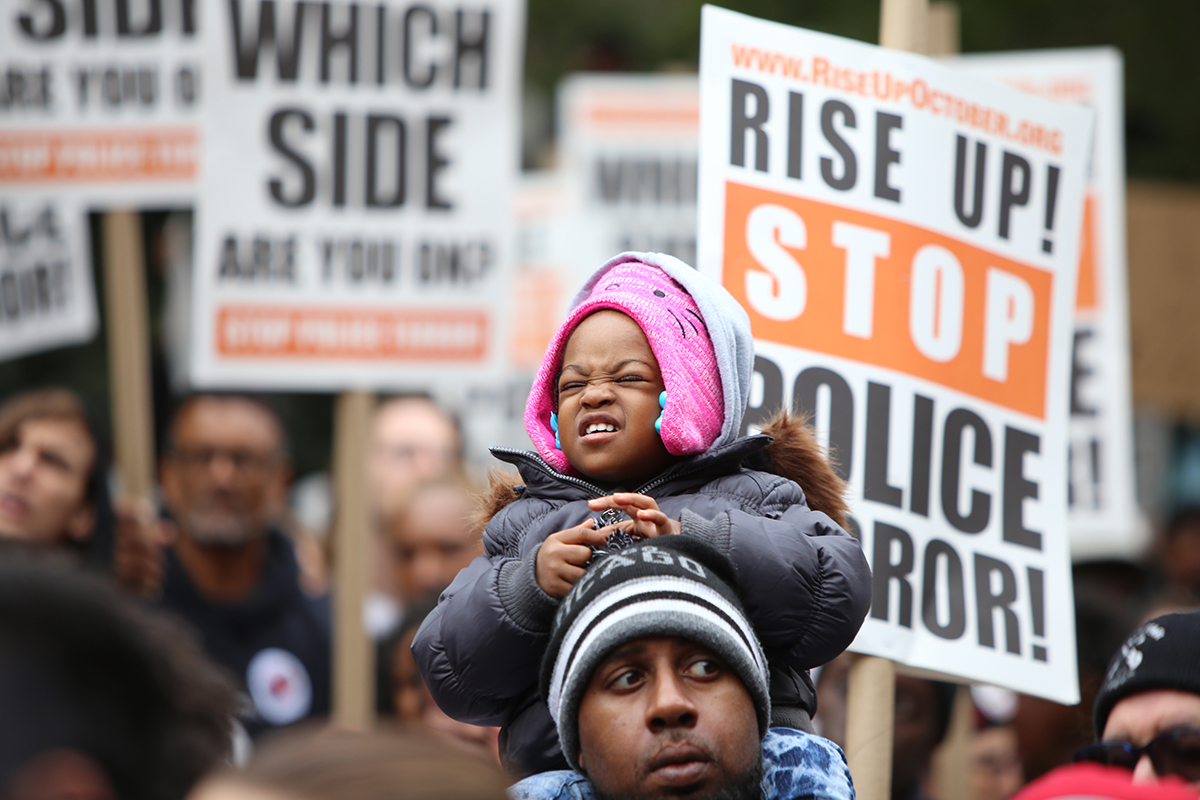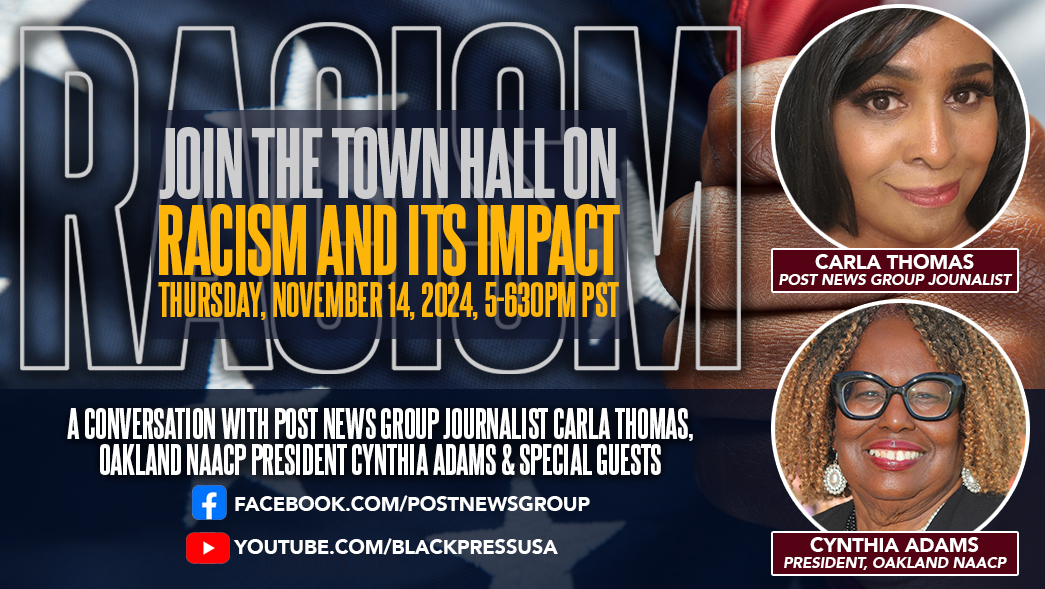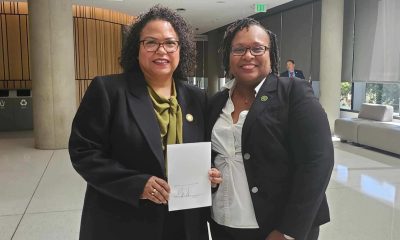Activism
Black Lawmakers Push Package of Bills to Regulate Police Brutality

The California Supreme Court ruled on Aug. 11 that Los Angeles County had to pay $8 million to the family of Darren Burley, an unarmed Black man who died under circumstances similar to George Floyd.
In 2012, Deputy David Aviles placed his knee on Burley’s neck and back while restraining him. Aviles weighs 200 lbs. Burley died 10 days later in the hospital.
The violent murder of George Floyd in Minneapolis at the hands of police has inflamed the country and sparked protests in California and around the nation and the world.
But the disproportionate use of excessive police force against Black men, too often ending up fatally, is not new to California.
“From Rodney King in 1991 to Stephon Clark in 2018, California has a bad history with excessive use of force by police officers,” said Assemblymember Chris Holden (D- Pasadena) in a news release.
In response to this, the California Legislative Black Caucus (CLBC) has authored a series of bills to reign in police violence. Those bills include:
- AB 1196, which would ban the use of the chokehold. It passed in the state Assembly and is now under review in the Senate Appropriations Committee.
- AB 1506. This would require police shootings to be investigated by a division of the Dept. of Justice. The State Assembly passed the legislation. It is currently under review in the Senate Appropriations Committee.
- AB 2342. This would allow parolees to reduce their terms by attending college or volunteering. It passed in the Assembly and is now under review in the Senate Appropriations Committee.
- AB 1022. This bill would require officers to report incidents of excessive force. The bill passed in the Assembly and the Senate Public Safety Committee. It is under review in the Senate Appropriations Committee.
- AB 1185. This would require an oversight board for sheriff’s departments. It passed in the Assembly and is now under review in the Senate Public Safety Committee.
California Attorney General Xavier Becerra praised Holden’s AB 1022, which is also called “the George Floyd” law.
“Americans across the nation demand more accountability in our criminal justice system,” said Becerra. “It’s going to take sustained, thoughtful reform like Assembly Bill 1022 to help answer the call. At the California Dept. of Justice, we’re committed to partnering with our legislators and stakeholders across the state to help get the job done.”
Becerra said he commends Holden and the bill’s other legislative supporters for getting it through the Senate Public Safety Committee. “Its time for important policies like a peace officer’s duty to intervene to be more than just recommendations. We’re ready for them to be the law of the land,” Becerra said.
Holden said Americans were shocked that officers didn’t intervene when they saw Minneapolis police officer Derek Chauvin choking the life out of Floyd. Instead, they formed a protective cordon around him and held off the crowd.
“We were outraged when we watched the killing of George Floyd by a Minneapolis police officer from a knee to the neck,” said Holden. “Equally disturbing, was the lack of intervention from the police officers who witnessed a clear use of excessive force.”
Activism
An Inside Look into How San Francisco Analyzes Homeless Encampments
Dozens of unhoused people are camped at Sixth and Jesse streets in San Francisco’s South of Market neighborhood. Tents made of tarps and blankets, piles of debris, and people lounging alongside the allies and walls of businesses are seen from all angles. These are some of the city’s hotspots. City crews have cleared encampments there over 30 times in the past year, but unhoused people always return.

By Magaly Muñoz
Dozens of unhoused people are camped at Sixth and Jesse streets in San Francisco’s South of Market neighborhood. Tents made of tarps and blankets, piles of debris, and people lounging alongside the allies and walls of businesses are seen from all angles.
These are some of the city’s hotspots. City crews have cleared encampments there over 30 times in the past year, but unhoused people always return.
But it’s normal to have tents set up again within less than 24 hours after an encampment sweep, David Nakanishi, Healthy Streets Operation Center Manager at the Department of Emergency Management, says. Sometimes there’s less people than before but often there is also no change.
“Most of the people that were in the encampments that want to go inside, we’ve gotten the majority of those [into shelter],” Nakanishi says. “Many of the people we encounter now, are those who have various reasons to not accept shelter, and some are already in shelter/housing”.
Since the ruling of Grants Pass by the US Supreme Court earlier this summer, which allows cities the authority to ban people from camping or sleeping on the streets, San Francisco has been at the head of the conversation to crack down on encampments.
Where neighboring cities in the Bay Area are clearing encampments a few days a week, San Francisco is sweeping 10 times a week, two per weekday.

David Nakanishi, Healthy Streets Operation Center Manager at the San Francisco Department of Emergency Management, makes a 311 report on an encampment in the Mission District. These reports allow smaller city teams to tackle individual spots where unhoused people frequent. Photo by Magaly Muñoz.
Considering the controversy that plagues the city around its harsh policies, the Post decided to tag along on a ride with Nakanishi to show us how he decides what encampments make it on the city’s sweep list.
Nakanishi, having over 20 years of experience in homelessness management, drives around the busiest parts of the city almost daily. He’s tasked with arranging a weekly sweeping operation schedule for city teams to engage with unhoused folks to help get them off the streets.
So what exactly is he looking out for when deciding what encampments get swept?
It depends, he says.
Locations like schools, recreational centers, senior centers, or businesses are places he tends to want to address quickly, especially schools. These are the places where the complaints are highest and access to facilities is important for residents.
He says he also takes into account 311 calls and reports made to him by city staff. On the date of publication, over 100 calls and reports were made about encampments around the city, according to San Francisco data.

Makeshift structures built from plywood and tarps are starting to pop up more throughout the city. Certain areas under freeways are not under direct authority from San Francisco, making it harder to sweep these encampments. Photo by Magaly Muñoz.
Nakanishi made a few 311 reports himself on the ride along, pulling over to take photos and describe the encampments into his 311 app. He says it helps him remember where to possibly sweep next or allows smaller teams in the city to engage quicker with individuals on the streets.
Nakanishi also looks at the state of the encampments. Are there a lot of bulky items, such as furniture, or makeshift structures built out of tarps and plywood, blocking areas of traffic? Is trash beginning to pile up and spill into the streets or sidewalks? Sites that meet this criteria tend to be contenders for encampment sweeps, Nakanishi says.
Street by street, he points out individuals he’s interacted with, describing their conditions, habits, and reasons for denying assistance from the city.
One man on 2nd St and Mission, who rolls around a blue recycling bin and often yells at passing pedestrians, has refused shelter several times, Nakanishi says.
People deny shelter for all kinds of reasons, he says. There’s too many rules to follow, people feel unsafe in congregate or shared shelters, or their behavioral and mental health problems make it hard to get them into proper services.

Inside a tent left by an unhoused man on Stevenson and 14th Street in San Francisco. The area smelled of human waste and leftover alcohol. Photo by Magaly Muñoz.
Nakanishi references another man on South Van Ness under the freeway, who city outreach have attempted to get into shelter, but his screaming outbursts make it difficult to place him without disturbing other people in the same space. Nakanishi says it might be an issue of the man needing resources like medication to alleviate his distress that causes the screaming, but the city behavioral team is in the process of outreaching him to figure that out.
In October, city outreach teams engaged with 495 unhoused people. 377 of those engaged refused shelter and only 118 accepted placements, according to city data. That number of monthly referrals is consistent throughout the entirety of 2024 so far.
Nakanishi has long advocated for the well-being of unhoused people, he explains. In 2004, he was working with the Department of Public Health and told then-Mayor Gavin Newsom that there needed to be more housing for families. Nakinishi was told it was easier to deal with individuals first and the city “will get there eventually.” 20 years later, family housing is still not as extensive as it could be, and the waiting list to get placements for families is a mile long with over 500 names.
In 2020, he was a Senior Behavioral Health Clinician at a hotel in the city during the pandemic. He says in 2021 he collaborated with DPH to provide vaccines to those staying in the makeshift hotel shelters once those became available.

Nakanishi strips apart a solo tent on Stevenson and 14th Street in San Francisco. He discards items, like tarps and cardboard, so that people cannot reuse them to make another sleeping structure. Photo by Magaly Muñoz.
Despite the constant media attention that city outreach is inhumanely treating homeless people, so much so that it has led to lawsuits against San Francisco from advocates, Nakanishi says not a lot of people are seeing the true conditions of some encampments.
He describes soiled clothing and tents, drenched in urine, and oftentimes rodents or bug infestations in places where people are sleeping. He’s asked homeless advocates- often those who are the most critical about the city’s work- who have shown up to observe the sweeps if those are conditions the city should allow people to be subjected to, but not many have answers for him, Nakanishi says.
The city’s “bag and tag” policy allows city workers to throw away items that are “soiled by infectious materials” such as bodily fluids and waste.
Sweep operations are conducted at 8am and 1pm Monday through Friday. People at the encampments are given 72 hour notice to vacate, but some don’t leave the area until the day of the sweep.
City outreach workers come out the day before and day of to offer resources and shelter to those interested. The Department of Public Works discards any trash that is left over from the sweep and washes down the area.
Nakanishi told the Post that the only time the city takes tents or personal possessions from residents is when folks become physically violent towards workers and police take the items as evidence. Other items taken are bagged and tagged in accordance with city policy.
Stories from local newspapers such as the San Francisco Standard and the Chronicle show instances of SFPD handcuffing residents while their items are thrown in the trash or disposing of personal possessions without reason.
Advocates have long been pushing for a more competent and compassionate process if the city is going to choose to continue sweeping unhouse people.
No matter the lawsuits and constant criticisms from allies, the encampment sweeps are not slowing down, even with the cold weather quickly approaching the coastal city.
Nakanishi says there aren’t a lot of large encampments left in San Francisco so now they do runs of streets in order to stretch out the sweeps as much as possible.
It’s calculated strategies and years of first hand knowledge that make this job work, “It takes dedication to the work, caring for the people and the community, and persistence, patience and sometimes good luck to make the positive changes for the people on the street,” Nakanishi says.
Activism
Oakland Post: Week of November 13 – 19, 2024
The printed Weekly Edition of the Oakland Post: Week of November 13 – 19, 2024

To enlarge your view of this issue, use the slider, magnifying glass icon or full page icon in the lower right corner of the browser window. ![]()
Activism
LIVE! — TOWN HALL ON RACISM AND ITS IMPACT — THURS. 11.14.24 5PM PST
Join us for a LIVE Virtual Town Hall on the Impact of Racism hosted by Post News Group Journalist Carla Thomas and featuring Oakland, CA NAACP President Cynthia Adams & other Special Guests.
Thursday, November 14, 2024, 5 p.m. – 6:30 p.m. PST

Join us for a LIVE Virtual Town Hall on the Impact of Racism hosted by Post News Group Journalist Carla Thomas and featuring Oakland, CA NAACP President Cynthia Adams & other Special Guests.
Thursday, November 14, 2024
5 p.m. – 6:30 p.m. PST
Discussion Topics:
• Since the pandemic, what battles have the NAACP fought nationally, and how have they impacted us locally?
• What trends are you seeing concerning Racism? Is it more covert or overt?
• What are the top 5 issues resulting from racism in our communities?
• How do racial and other types of discrimination impact local communities?
• What are the most effective ways our community can combat racism and hate?
Your questions and comments will be shared LIVE with the moderators and viewers during the broadcast.
STREAMED LIVE!
FACEBOOK: facebook.com/PostNewsGroup
YOUTUBE: youtube.com/blackpressusatv
X: twitter.com/blackpressusa
-

 Alameda County3 weeks ago
Alameda County3 weeks agoAlameda County District Attorney Pamela Price Announces $7.5 Million Settlement Agreement with Walmart
-

 Activism3 weeks ago
Activism3 weeks ago‘Jim Crow Was and Remains Real in Alameda County (and) It Is What We Are Challenging and Trying to Fix Every Day,’ Says D.A. Pamela Price
-

 Bay Area3 weeks ago
Bay Area3 weeks agoIn the City Attorney Race, Ryan Richardson Is Better for Oakland
-

 Activism3 weeks ago
Activism3 weeks agoOakland Post: Week of October 30 – November 5, 2024
-

 Alameda County2 weeks ago
Alameda County2 weeks agoD.A. Price Charges Coliseum Flea Market Vendors in Organized Retail Theft Case
-

 Activism3 weeks ago
Activism3 weeks ago‘Criminal Justice Reform Is the Signature Civil Rights Issue of Our Time,’ says D.A. Pamela Price
-

 Activism3 weeks ago
Activism3 weeks ago“Two things can be true at once.” An Afro-Latina Voter Weighs in on Identity and Politics
-

 Arts and Culture3 weeks ago
Arts and Culture3 weeks agoMacArthur Fellow Jericho Brown’s Poetry Reflects Contemporary Culture and Identity






















































